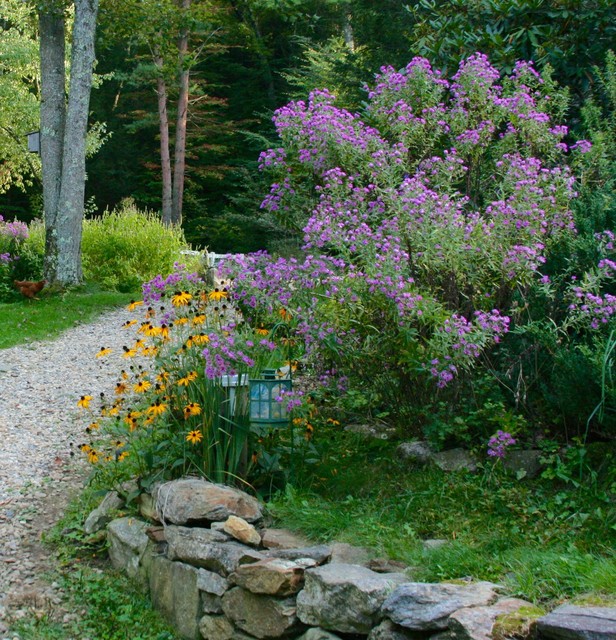

Gardens and conventional landscapes are not the only choices, nor necessarily the best. Having planting areas on both sides of a path, especially when the same plant appears to cross the path in a drift, can add a lot of charm. Nothing beats the sight of red berries against the snow, of course. Grasses and the stalks of many perennials are much more interesting to look at than bare mulch beds - how much editing is needed is a matter of taste. The color of fall foliage is well worth considering, as is the structure and texture of trunks and stems. Can you arrange the plantings in a way to create the effect of a garden room when viewed from a window where people sit? This is likely to be more enjoyable than a distant vista. Spring ephemerals in particular will be enjoyed most if they are along your usual walkway so they can be seen even in bad weather, or outside a window. To appreciate small plants, it helps to put them near where you walk. If the garden will mostly be seen from a distance, large plants with bold foliage will stand out better, as will yellow, orange and pink. Tiny plants next to a huge building, or vice versa, will look out of balance.Ĭonsider the vantage point of the viewer.

Signs such as wildlife habitat certification signs or interpretive signs Human-made objects - benches, pieces of art Plant frames could consist of plants with vertical lines, such as Iris versicolor or Common Rush (Juncus effusus), or of much shorter plants, such as Moss Phlox (Phlox subulata) or Crested Iris (Iris cristata). Random assortments of plants tend to look weedy, but an otherwise unintelligible planting can be made recognizable as an intentional design by adding “cues to care” such asįrames - can be made of plants, a strip of mowed lawn, or fences or walls. Using plants to create an entranceway allows for a graceful transition between street and building. Obscuring part of the view makes the space seem larger. Or you could create clumps by cutting the surrounding plants down to the ground See the list for some example of plants that can be treated this way). The flowers may be more numerous but smaller. The plant will be shorter and more compact. For example, you could cut back by half the summer- and fall-blooming plants in the front half of the border in the late spring (this will also result in those plants blooming later than the ones behind. If you find yourself with an expanse of plants that all look alike, cut back some of them to achieve variety of height.

Adding other plants can also give you more winter interest.Īdd colorful pots or other human objects.Įdit existing plants to create the effect of variety Include ferns, vines, clumps of grasses and shrubs.Ī flower garden need not consist of perennials alone. Shrubby Saint John’s Wort (Hypericum prolificum) Threadleaf Coreopsis (Coreopsis verticillata) Virginia Spiderwort (Tradescantia virginicus) Intersperse plants with strikingly different foliage or heights. They say that a good way to plan a garden is to design it for the foliage, not just for the flowers. This can be boring when they are not in bloom. Many summer-blooming perennials for sun have similar foliage and will grow almost in lockstep to approximately the same height. You can control that by using lines to give a sense of movement and by providing a focal point, which can be a human-made object such as a bench or statue, or a particularly noticeable plant.
#NATIVE PLANT GARDEN DESIGN PATCH#
You want it to rest on a place of your choosing, not on some patch of dead leaves or an air conditioning unit. The human eye will rove around forlornly until it finds somewhere to rest. You don't want your design to look lopsided when one plant grows more quickly or densely than its matching partner. It is helpful to provide some sense of order by repeating a color or shape throughout the garden.īalance is not the same as exact symmetry, which is difficult to achieve with growing plants. The human brain gets confused by total randomness.

When making a grouping, odd numbers of plants look better in most situations. If you already have a garden that lacks eye-catching elements, add some punctuation marks. If you are starting with a clean slate, think about the eye-catching elements first, just as if your were starting a painting and sketching in the people and building. South and west side of buildings to reduce air conditioning costs Overhead and underground lines and other facilities Conventional garden design principles apply equally to native plant design.


 0 kommentar(er)
0 kommentar(er)
